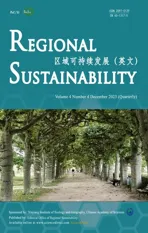Impact of forest governance and enforcement on deforestation and forest degradation at the district level: A study in West Bengal State, India
2024-01-11AishwaryaBASUJyotishPrakashBASU
Aishwarya BASU , Jyotish Prakash BASU
a University of Burdwan, Burdwan, 713104, India
b West Bengal State University, Kolkata, 700126, India
Keywords:Deforestation Forest degradation Forest governance index Enforcement index Illegal logging Logistic regression model India
ABSTRACT: According to the United Nations Environmental Programme (UNEP), the world loses 1.0×106 hm2 forest land through deforestation annually.About 1.6×106 people who depend on forests for livelihood are negatively affected by deforestation and forest degradation.The paper attempts to study the impact of forest governance, enforcement and socio-economic factors on deforestation and forest degradation at the local level in West Bengal State,India.The study was based on questionnaire survey data during 2020–2021 collected from three western districts (Purulia, Bankura, and Paschim Medinipur) where deforestation and poverty rates are higher than other districts in West Bengal State.The total number of selected villages was 29,and the total sample households were 693.A stratified random sampling technique was used to collect data, and a questionnaire was followed.Forest governance and enforcement indices were constructed using United Nation Development Programme (UNDP) methodology and a step-wise logistic regression model was used to identify the factors affecting deforestation and forest degradation.The result of this study showed that four factors (illegal logging, weak forest administration, encroachment, and poverty) are identified for the causes of deforestation and forest degradation.It is observed that six indices of forest governance (rule of law, transparency, accountability,participation, inclusiveness and equitability, and efficiency and effectiveness)are relatively high in Purulia District.Moreover, this study shows that Purulia and Bankura districts follow medium forest governance, while Paschim Medinipur District has poor forest governance.The enforcement index is found to be highest in Purulia District (0.717) and lowest for Paschim Medinipur District (0.257).Finally, weak forest governance, poor socio-economic conditions of the households, and weak enforcement lead to the deforestation and forest degradation in the study area.Therefore,governments should strengthen law enforcement and encourage sustainable forest certification schemes to combat illegal logging.
1.Introduction
Deforestation contributes significantly to CO2emissions, making up approximately 17.00%–20.00% of global greenhouse gas emissions (IPCC, 2007).The impact of deforestation on CO2emissions is notably higher in tropical regions than in temperate zones (Sloan and Sayer, 2015).Deforestation and forest degradation occur due to various anthropogenic and natural factors like agricultural land expansion (Gayen and Saha, 2018), illegal logging (World Bank, 2018; Tacconi and Williams, 2020), urbanization (Karanth and de Fries, 2010), climate change, mining activities, and economic development (Delabre et al., 2020) including infrastructure development such as the construction of hydroelectric projects (Malik et al., 2016) and insecure land tenure.
Various socio-economic and demographic factors (poverty, illiteracy, low family income, pre-dominance of small farmers, and large family size) are directly associated with forest degradation (Ullah et al., 2023).The unsustainable harvesting of fuelwood for cooking is also responsible for forest degradation in India and Nepal (Shrestha et al., 2018).
In India, 93.00% of forest land ownership is held by the state forest department, 4.00% by the state revenue department,and 3.00% by the private entities (MoEF, 2006).Approximately1.73×104villages are located in and around forests (Basu,2017), and 2.75×106–4.00×106communities depend on forests for livelihoods (Saha and Guru, 2003).These large numbers of communities derive their livelihoods from forests and may resort to illegal activities, like illegal logging and the encroachment of forest land (Ostermann, 2016), which lead to the degradation of forest ecosystems.On the other hand,communities that depend on forests for their livelihoods are also affected by deforestation and forest degradation, as they affect the supply of ecosystem services on which people’s livelihood depend (Carrasco et al., 2017).
The pre-independence forest policies of India, such as the Forest Policy of 1894 and 1952, focused on the expansion of agriculture, which has led to deforestation (Joshi et al., 2011).The pre-independence Forest Act of 1865, 1878, and 1927 concerned on timber production and revenue generation (Ghosh and Sinha, 2016).These acts encouraged deforestation.In the first National Forest Policy of 1952 in post-independent India, priority was given to the commercial exploitation of forests at the cost of the needs of local communities (Ghosh and Sinha, 2016).In the 1970s, there was a state-led forest management practice in India and such management practice could not solve the problem of the Tragedy of the Commons (Ostrom, 1990;Agrawal and Ostrom, 2001).The Forest Conservation Act of 1980 aimed to ensure the conservation of forests and wildlife and prevent forest resource depletion.Despite the Forest Conservation Act, deforestation remains a significant problem in India.The National Forest Policy of 1988 focused on environmental stability, ecological balance, and the conservation of forest resources (MoEF, 1988).Based on the National Forest Policy, the Government of India announced Joint Forest Management (JFM) in 1990, involving local communities in protecting forests.There are various formal and informal institutions, namely Forest Protection Committees (FPCs), Joint Forest Management Committees (JFMCs), and Panchayati Raj Institutions (PRIs) associated with implementing the JFM program in India.The JFM program in India has some flaws.The JFMCs in India are not independent institutions, but are controlled by the forest department in preparing management plans (Behera and Engel, 2004).In addition, the beneficiaries of the JFM program are ultimately the elite class (Roy, 2006).The forest department has bureaucratic control over the JFMCs to formulate rules and regulations of forest policies (TERI,2004).There are continuous conflicts between the forest department and local communities.Thus, the existing JFM program should give more attention to monitoring and implementing for addressing illegal logging and forest degradation.In this context, effective forest governance is essential for finding the drivers of deforestation and forest degradation, while the enforcement of rules and regulations on forest utilization and forest harvesting is a prerequisite for controlling illegal activities prevalent in the forest sector (Gaveau et al., 2009; Pandit et al., 2016).
Forest governance is a tool for implementing laws, regulations, norms, and the participation of multiple stakeholders,which enforce the decisions about forest management and conservation (FAO, 2011) for reducing deforestation and forest degradation.Monitoring and enforcing extant rules by community-based institutions could also help arrest deforestation and promote forest regeneration (Nagendra and Gokhale, 2008).With the enforcement of local-level rules, the probability of reducing forest degradation increases, which also facilitates the generation of new forests (Chhatre and Agrawal, 2008).
There are some studies on forest governance in India (Bose, 2011; Bose et al., 2012; Mohanty and Saha, 2012;Christoph et al., 2015; Basu, 2020, 2021), and most of these studies did focus on the measurement and determinants of forest governance in West Bengal, Orissa, and Rajasthan states in India, rather than deforestation and forest degradation.It is worthwhile to mention some other studies which deal with the quantitative assessment of cross-country forest governance based on the secondary data (Pellegrini and Gerlagh, 2006; Richard et al., 2007;Galinato and Galinato, 2013; Joshi and Beck, 2017; Bösch, 2021; Minlah and Zhang, 2021).Most studies are conducted at the global, national, or regional level, but a few researches are available at the micro or local level.In addition, few of these studies have conducted quantitative analysis of forest governance at the local or household level.
This paper proposes three hypotheses.First, various socio-economic factors have an impact on deforestation and forest degradation.Second, weak forest governance has an impact on deforestation and forest degradation.Third, both the weak rules and regulations of forest enforcement impact deforestation and forest degradation.
Against this backdrop, the objectives of the paper are set as follows.The first is to assess forest governance index and formulate enforcement index based on different factors at the local or household level in three western districts (Purulia,Bankura, and Paschim Medinipur districts) in West Bengal State, India.The second is to estimate the impacts of forest governance, enforcement, and socio-economic factors on deforestation and forest degradation at the local level.The paper utilized the forest governance index based on the leading indices of Food and Agriculture Organization (FAO):participation, rule of law, inclusiveness and equitability, accountability, efficient and effectiveness, and transparency.
The study is unique for the following three reasons.Firstly, this study focused on the conservation of biodiversity.Secondly,the research analysed the mitigation measures of climate change, i.e., reducing emissions from deforestation and forest degradation (REDD+).Thirdly, this study was based on the Sustainable Development Goal 15 (Life on Land) of the United Nations.Finally, the research proposed an efficient management of forest resources.
Chatham House reviewed forest policies of some Asian countries in 2008 and 2018, including legal and institutional framework, regulating demand, and rule of law, as presented in Table 1.The scores of legal and institutional framework in 2018 were weak in China, Thailand, and Malaysia but fair in Japan, Indonesia, and South Korea, while India’s position was falling (Table 1).The assessment scores for regulating demand in 2018 were weak in India, Indonesia, and Malaysia, while the scores were fair in China and Thailand, and good and very good in South Korea and Japan,respectively (Table 1).Again, the scores of the rule of law were weak in China, India, Japan, and Thailand, while they were fair in Malaysia and South Korea and good for Indonesia, in 2018 (Table 1).
2.Materials and methods
2.1.Study area
The study area incuding Purulia, Bankura, and Paschim Medinipur districts is located in West Bengal State, India(Fig.1).The forest cover of this state is 19.04%, as against 24.00% of India in 2019.
Purulia District mainly consists of undulating terrain with scattered hills and forests.The district is dominated by dry deciduous forests.The major forest types are Sal (Shorearobusta) forests.Some of the common tree species are found in the forests of Purulia District, including Sal, Mahua (Madhucalogifolla), Palash (Buteamonosperma), and Kusum(Schieichera).In recent years, the forests of Purulia District have faced several challenges, including the deforestation and forest degradation due to anthropogenic activities such as logging, grazing, and mining.These activities have led to a decline in the district’s overall forest cover and biodiversity.The forest cover has decreased from 20.95% in 2000 to 14.00% in 2018.This district is dominated by scheduled tribes and scheduled castes.It is the second highest tribal concentrated district where the population of scheduled tribes (18.29%) and scheduled castes (18.27%) together constituted 36.56% of the total population.

Table 1Forest policy assessment in Asian countries in 2008 and 2018.

Fig.1.Location of Purulia, Bankura, and Paschim Medinipur districts in West Bengal State, India.
Bankura District has a predominantly undulating topography, with scattered hills and forests.This district is dominated by dry deciduous forests, with a few pockets of semi-evergreen and moist deciduous forests.The primary forest species found in the forests of Bankura District are Sal (Shorearobusta), Mahua (Madhucalogifolla), Palash(Butea monosperma), and Kusum (Schieichera).The forest cover of this district is 18.68%, with 17.37% of dense forests, 30.90% of moderately dense forests, and 51.73% of open forests (FSI, 2019).This district is recognized as a drought-prone region, characterized by extreme temperature, scarce rainfall, and a combination of plateau fringe and alluvial plains.Deforestation and forest degradation are the common challenges faced by Bankura District.
Paschim Medinipur District has a diverse topography, with plains in the east and hills and forests in the west.Paschim Medinipur District is dominated by dry deciduous forests, with Sal (Shorearobusta) forests being the dominant forest type.Other tree species discovered in this district include Mahua (Madhucalogifolla), Palash (Butea monosperma), and Kusum(Schieichera).The forest cover comprises 23.07% of its area, with 11.85% of dense forests, 27.38% of moderately dense forests, and 60.77% of open forests (FSI, 2019).The district is one of the under-developed districts in West Bengal State,with a majority population of scheduled castes (18.69%) and scheduled tribes (11.43%) (Government of India, 2011).
These three districts were selected for the following reasons.Firstly, these three districts have a high concentration of scheduled tribes and scheduled castes.Secondly, these districts have witnessed high deforestation rates compared to other districts in West Bengal State.Thirdly, these districts are poverty-ridden and economically backward.
2.2.Data collection
The study is based on primary data collected from Purulia, Bankura, and Paschim Medinipur districts, during 2020–2021.A multistage random sampling technique was followed to select the ultimate household units.At the first sampling stage, we selected the forest offices of these three districts based on the highest forest cover; and the second stage was the selection of villages.Priority was given to the areas where there was a high concentration of scheduled tribes and scheduled castes.After selecting villages, we collected information on the total number of households in each sample village from local governments like the Gram Panchayat Office of the villages concerned.Then, 20.00% of households from each village were selected randomly.This selection criterion is based on the minimum sample size (i.e., 500) required for the statistical and econometric analysis (Bujang et al., 2018).Thus, the total number of the sample households is 693,and the total number of villages is 29.After the selection of households, we collected primary data following the interview method based on a structured questionnaire.The details of the sample households are presented in Table 2.
The questionnaire survey data consist of socio-economic conditions (such as age, caste, family size, education,poverty, land holdings, sources of livelihoods, and income), forest-related resources (fuelwood, non-timber forest products, deforestation, and illegal logging), forest governance (rule of law, transparency, accountability,participation, inclusiveness and equitability, and efficiency and effectiveness), and enforcement.
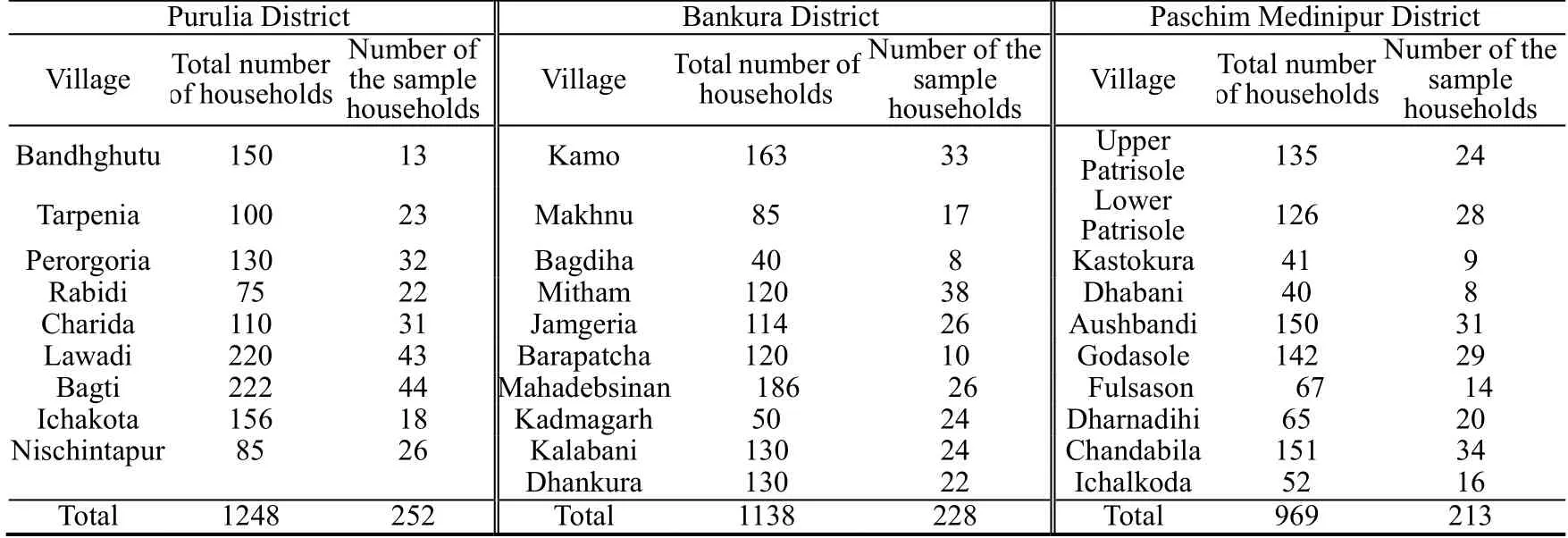
Table 2Distribution of the sample households across different villages in Purulia, Bankura, and Paschim Medinipur districts.
2.3.Data analysis
2.3.1.Forest governance and enforcement indices
Forest governance can be measured by the forest governance index (Mohanty and Saha, 2012; Situmorang et al., 2015; Pant,2021).The calculation of the forest governance index is based on six main indices: participation, rule of law, inclusiveness and equitability, accountability, efficiency and effectiveness, and transparency; and each index is again divided into several sub-indices.These sub-indices were selected on discussion with local elders and forest beat officers in the study area.Then,each head of the sample households was asked to respond with his or her views on a three-point Likert scale (yes=1, no=2, and do not know=3).Then, we normalized the responses of the households on each sub-index.The normalized value lies between 0 and 1.This normalization procedure was followed by the method of the Human Development Index (UNDP, 2006).After normalization, we took the averages of all sub-indices.Once all sub-indices have been made, we can obtain leading index.The simple average of all main indices with equal weights is the forest governance index.This index value lies between 0 and 1.The higher the index value, the better the forest governance; and vice versa.
Likewise, enforcement was measured by formulating an enforcement index (Basu, 2021).The construction of the enforcement index considered these indices: forest patrols; reporting of illegal activities; need of permission to collect or harvest forest product; and issuance of permit by the correct authority.Then, the sample households were individually asked to respond with their views on a three-point Likert scale (yes=1, no=2, and do not know=3).The simple average of all indices is the enforcement index.A higher enforcement index represents the strengthening of enforcement, and vice versa.
2.3.2.Model specification and estimation technique
A logistic regression model has been used to estimate the factors affecting deforestation (Echeverria et al., 2008;Rossiter and Loza, 2008; Bera et al., 2020; Bösch, 2021).The dichotomous dependent variable in the logistic regression model is deforestation or no deforestation.It is based on the binary response variables (1 for deforestation and 0 for no deforestation) (Rivera et al., 2012).More specifically, during the field survey, households were asked to respond on whether deforestation had occurred or not.If it happened, we put 1 in the logistic regression model,otherwise 0 was put in the model; thus, the dependent variable took either 1 or 0.The independent variables are forest governance index, enforcement index, education index, land holdings, forest income, age of households, and caste of households.It is hypothesized that deforestation and forest governance index show an opposite relationship with enforcement index and education index.On the other hand, there is a positive impact of forest income and land holding on deforestation.These hypotheses were proposed in consultation with forest departments and local elders.
A step-wise logit model was applied to avoid multi-collinearity problems, and the logit model to be estimated is as follows:
where,Piis the probability of deforestation and forest degradation;x1,iis the forest governance index;x2,iis the enforcement index;x3,iis the education index of the households;x4,iis the land holdings;x5,iis the percentage of forest income to total income each month (%);x6,iis the age of households (years old);x7,iis the caste of households;β0is the intercept; andβ1,β2,β3,β4,β5,β6, andβ7are the coefficients of independent variables.
3.Results
3.1.Socio-economic characteristics of the sample households
The socio-economic characteristics of sample households in the three districts are shown in Table 3, and it can be seen that about 72.15% of households belong to scheduled castes and scheduled tribes.The heads of households are primarily males (90.76%), and the educational structure of the sample households shows that in the three selected districts, about 52.81% of the household heads are illiterate.The average family size of the sample households is 4.53, and about 92.78%of the sample households live below the poverty line (Table 3).It is also observed that 23.38% of the sample households are landless farmers while others are either marginal (<0.067 hm2/household) or small (≥0.067 hm2/household) farmers.The average monthly income in the three districts is 100.14 USD with about 21.45% of the total income from forests.Forest income accounts for 16.00%–24.00% of the total income across the three districts (Table 3).
Forest dependency of the sample households is presented in Figure 2.The households mainly depend on fuelwood for cooking and non-timber forest products for household income, such as mushroom, sal seeds, and mahua flowers.Sal seeds are used to make plates, which can be sold in the markets.Mahua flowers provide nutritious foods for tribal communities and are also used for making liquor.
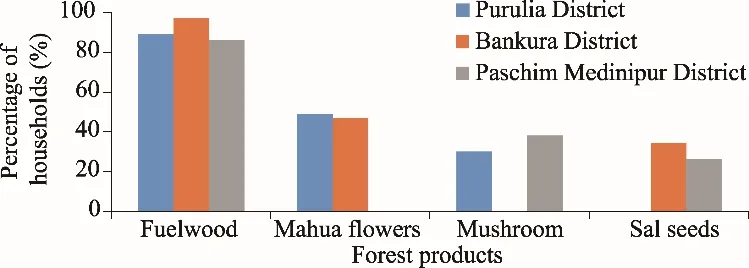
Fig.2.Forest products of households used in Purulia, Bankura, and Paschim Medinipur districts.
It is evident that more than 80.00% of the sample households in the three districts collect fuelwood from forests; a part of fuelwood is used to meet their energy requirements, and the rest is sold in the markets for sustenance (Fig.2).About 47.00%–49.00% of the sample households in Purulia and Bankura districts collect mahua flowers from forests.Mushroom is available in Purulia and Paschim Medinipur districts, while sal seeds are only available in Bankura and Paschim Medinipur districts (Fig.2).
The sample households identified four factors for deforestation: illegal logging, weak forest administration,encroachment, and poverty (Fig.3).Over 90.00% of the sample households expressed weak forest administration as responsible for deforestation in the three districts.Poverty is another cause of deforestation, and this is the dominant factor in Paschim Medinipur District (89.00%), followed by Bankura District (88.00%) and Purulia District (70.00%).Illegal logging, which is also responsible for deforestation, is found to be the major factor in Bankura District (82.00%),followed by Paschim Medinipur District (71.00%) and Purulia District (60.00%).In addition, another factor for deforestation is the encroachment indulged by political parties, and this is found to be the highest for Purulia District(72.20%), followed by Bankura District (72.00%) and Paschim Medinipur District (59.60%) (Fig.3).

Fig.3.Factors of deforestation and forest degradation identified by the sample households in Purulia, Bankura, and Paschim Medinipur districts.
3.2.Forest governance index
The description of different indices of forest governance is presented in Table S1 and the values of forest governance index in different districts are shown in Table S2.Forest governance index is the highest in Purulia District (0.446),followed by Bankura District (0.397) and Paschim Medinipur District (0.320).
The main indices, including rule of law, transparency, accountability, participation, inclusiveness and equitability,and efficiency and effectiveness, in the three districts are shown in the Radder diagram (Fig.4).It is observed that the six indices are relatively high in Purulia District.Moreover, the transparency index is the highest in Bankura District(Fig.4), while Paschim Medinipur District lags behind the other two districts with respect to all indices.
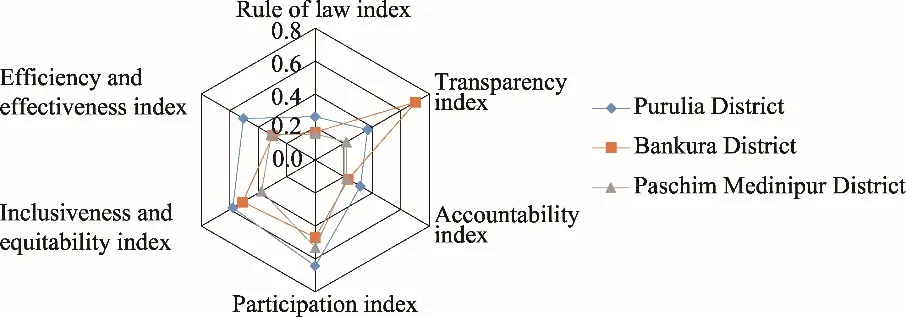
Fig.4.Rader diagram showing the six main indices of forest governance in Purulia, Bankura, and Paschim Medinipur districts.
We classified forest governance as excellent, good, medium, and poor categories, based on the values of forest governance index.Excellent forest governance is defined when the forest governance index is greater than 0.73, good forest governance is that the forest governance index lies between 0.49 and 0.73, medium forest governance is that theforest governance index is in the range of 0.24–0.49, while poor forest governance means that the forest governance index is less than 0.24 (Basu, 2023).It is observed that Purulia and Bankura districts follow medium forest governance,while Paschim Medinipur District has poor forest governance (Table 4).

Table 3Socio-economic characteristics of the sample households in Purulia, Bankura, and Paschim Medinipur districts.

Table 4Performance of forest governance in Purulia, Bankura, and Paschim Medinipur districts.
3.3.Enforcement index
The description of different sub-indices of enforcement index is presented in Table S3.The enforcement index is found to be the highest in Purulia District (0.501) and the lowest in Paschim Medinipur District (0.257) (Table 5).The highest value of enforcement index in Purulia District indicates that the local communities are performing better in preventing illegal logging by participating in forest patrolling.Besides, they follow the rules and regulations framed by the forest protection committees regarding forest product collection and harvesting of timber.

Table 5Enforcement index values in Purulia, Bankura, and Paschim Medinipur districts.
3.4.Determinants of deforestation and forest degradation
We selected a logistic regression model to estimate the factors impacting deforestation and forest degradation at the local level.The explanatory variables and their basic statistics are presented in Table 6.The dependent variable is the probability of deforestation andforest degradation.

Table 6Basic statistics of independent and dependent variables in the logistic regression model.
We computed various statistical tests like Akaike Selection Criterion (AIC), Likelihood Ratio (LR)chi2(χ2), PseudoR2, and Log likelihood for the model’s soundness, and the test values are provided in Table 7.Four explanatory variables (forest governance index, enforcement index, educational index, and land holdings) provide the best-fit based on the highest values of LRchi2(χ2) and PseudoR2, and the lowest value of AIC (Table 7).The result shows that the probability of deforestation and forest degradation reduces with the increase of forest governance index, and vice versa.Again, the probability of deforestation and forest degradation increases with the decrease of the enforcement index, and vice versa.In addition, land holdings show positive and significant relationship with the probability of deforestation and forest degradation, which implies that the expansion of agricultural land is associated with deforestation.
4.Discussion
The results show that rule of law was weak in India at the household level.The socio-economic conditions of the sample households are poor in terms of high poverty, illiteracy, and dominance of small and marginal farmers.The poor socio-economic conditions have led to deforestation and forest degradation, supporting the result of Shrestha et al.(2018) in Nepal.More than 80.00% of the sample households are dependent on fuelwood in Purulia, Bankura, and Paschim Medinipur districts, and they also rely on non-timber forest products, leading to deforestation and forest degradation.A similar result was found in the study of Khan et al.(2017) in Pakistan, in which forest dependency of households is the source of livelihood and the driver of deforestation.
This study has formulated forest governance index in the three western districts of West Bengal State, and these districts show medium or poor forest governance.The low index values of rule of law and accountability explain the causes of weak forest governance.The study of Bruce et al.(2018) found that poor forest governance and minimum participation of local communities in the forest management program in Cameroon are the drivers of deforestation.On the other hand, the same result of poor forest governance is found in the study of Regional Community Forestry Training Centre for Asia and the Pacific (RECOFTC (2018)) in Myanmar.The participation index is supposed to be the highest in the present study, with high participation by communities helping them empower and prevent deforestation.The studies of Schroeder (2010) and Ardiyanto et al.(2022) also indicated the same results in Indonesia.
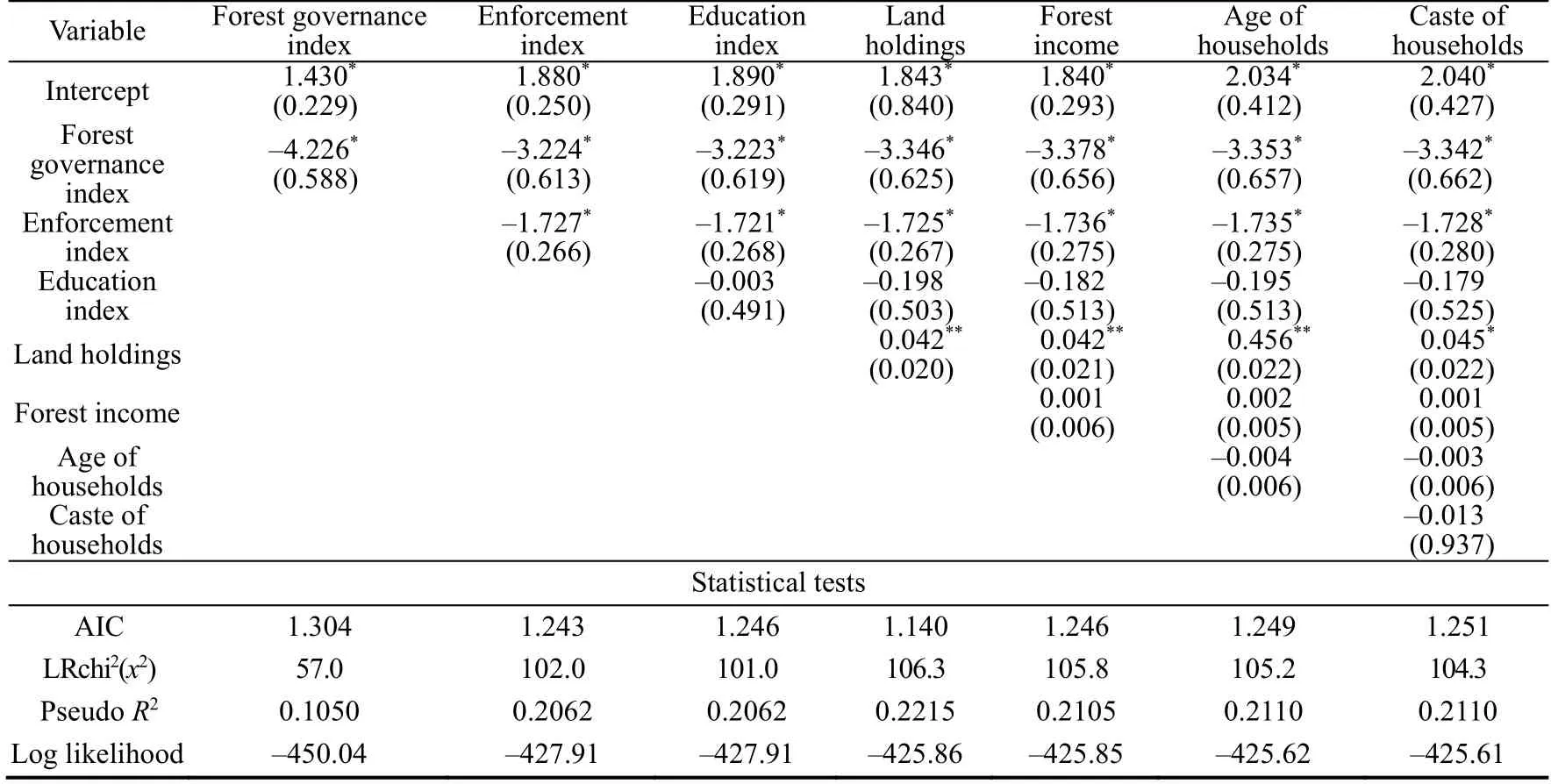
Table 7Estimates of logistic regression model.
This study has identified four primary factors of deforestation and forest degradation: illegal logging, weak forest administration, encroachment (backed by political parties), and poverty.The studies of Reboredo (2013), Waldhoff and Vidal (2015), and Tacconi et al.(2019) also showed that in Brazil, poverty can impact on deforestation, specifically,poverty forces to resort to illegal activities, including deforestation, for livelihood maintenance.
In Indonesia, the high rates of deforestation are explained by illegal forest activities, and such actions are well-documented in the studies of Palmer (2001), Casson and Obidzinski (2007), and Luttrell et al.(2011).The main drivers of deforestation identified in Cameroon are population growth, agricultural expansion, and illegal logging (Bellassen and Gitz, 2008).
The estimated result establishes a negative relationship of forest governance with deforestation and forest degradation, which means that the probability of deforestation and forest degradation increases with the decrease of forest governance, and vice versa (Barbier et al., 2005; Galinato and Galinato, 2013).Good forest governance is necessary for a decrease in deforestation (Umemiya et al., 2010; Hanneke et al., 2022).
The result of enforcement index shows that enforcement index is weak across the three districts, such as Paschim Medinipur District, on account of disobeying the rules and regulations framed by the forest protection committee and performing non-cooperation for forest patrolling with the forest guard.The impact of enforcement on deforestation and forest degradation is negative and significant, implying that the probability of deforestation and forest degradation decreases with the increase of enforcement index, and vice versa.
Weak enforcement contributes to deforestation and forest governance (Downs and Tacconi, 2017; Tacconi et al., 2019).There is a debate regarding applying full versus incomplete enforcement in the forest sector (Robinson et al., 2010).In this study, small-scale illegal activities in the forest sector are in practice, which exert an important impact on poverty and livelihood needs.Thus, it is necessary to acknowledge incomplete enforcement and implement a fine system (Gaveau et al.2009; Ostermann, 2016; Pandit et al., 2016).Moreover, when large forest companies carry out large-scale illegal activities for a high-profit margin, full enforcement needs to be imposed from an environmental point of view (Tacconi et al., 2016).Strengthening enforcement is only sometimes helpful in solving illegal activities (Smith et al., 2006; Tacconi, 2007;Goncalves et al., 2012) in Indonesia.Further, the result on the positive relationship of land holdings with deforestation and forest governance is same with the previous studies of Probst et al.(2020) and Yanai et al.(2022) in Brazil, where larger land holding farms usually encroach forest land, which intensifies deforestation and forest governance.Moreover, the deforestation patterns in the Amazon are changing, and the contribution of smallholding farms to deforestation has been increasing in recent years (Assunçãoet al., 2017; Kalamandeen et al., 2018).
5.Conclusions, policy suggestions and limitations
The following conclusions can be derived from this study.Firstly, the weak forest governance, enforcement, and poor socio-economic conditions have led to a higher probability of deforestation and forest degradation in three western districts(Purulia, Bankura, and Paschim Medinipur districts) of West Bengal State, India.Secondly, the study has identified that weak enforcement caused by weak forest administration and the involvement of political parties in indulging illegal encroachers, and poverty-driven illegal logging have resulted in the intensification of deforestation and forest degradation.
The study calls for policy suggestions for reducing deforestation and forest degradation in India.The suggestions include promoting sustainable fuelwood harvesting practices (such as using efficient stoves and cultivating fuelwood plantations), and facilitating alternative livelihoods for forest-dependent communities (eco-tourism, sustainable non-timber forest product harvesting, and agro-forestry) that can reduce pressure on forests and improve rural livelihoods.Emphasis should be given to formulating effective forest governance policies, such as payments for ecosystem services, which can also help to promote the sustainable utilization and management of forest resources.Forest governance should be strengthened by improving the capacity of forest departments, cooperating with other departments (namely rural development, agriculture, irrigation, and animal husbandry departments), increasing community participation in forest management, and promoting transparency and accountability in decision-making process.Moreover, governments should strengthen enforcement and promote sustainable forest certification schemes to combat illegal logging.
Future research should focus on developing more effective and integrated approaches to prevent deforestation and forest governance, by considering the complex socio-economic and environmental factors and leveraging emerging technologies to enhance forest monitoring and management.
Authorship contribution statement
Aishwarya BASU: data collection, hypothesis formulation, methodology, econometric analysis, and writing -original draft; and Jyotish Prakash BASU: conceptual framework, discussion, and policy suggestions and editing.
Ethics statement
Ethics approval was obtained from the Ethics committee of West Bengal State University.In addition, the participants provided their informed consent to participate in this study.
Declaration of competing interest
The authors declare that they have no known competing financial interests or personal relationships that could have appeared to influence the work reported in this paper.
Acknowledgements
The authors are thankful to Prof.Pravat Kumar KURI (Department of Economics, Burdwan University) for valuable suggestions helping to prepare the article.
Appendix
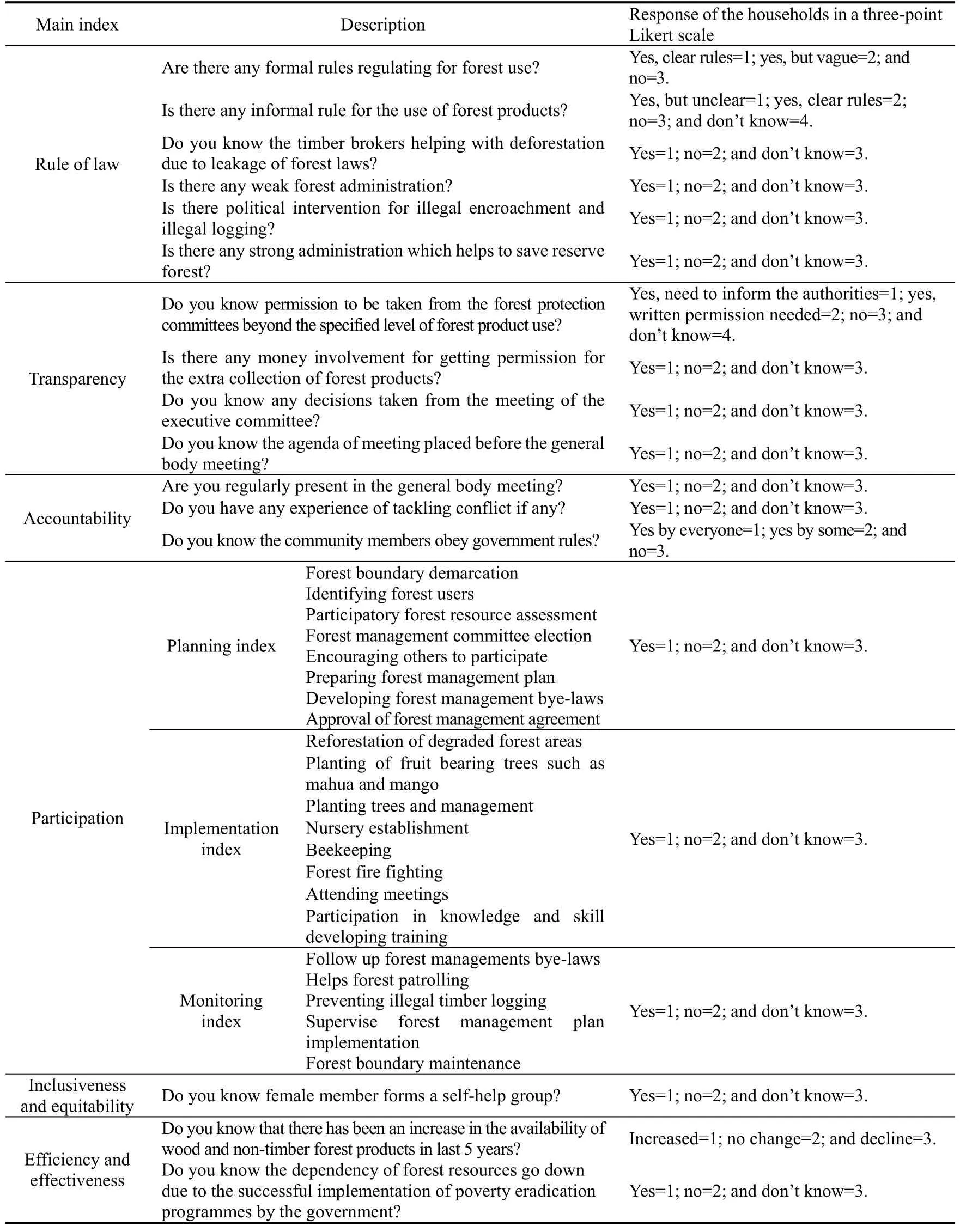
Table S1Description of main index of forest governance index.

Table S2Forest governance index across the three western districts in West Bengal, India.

Table S3Description of sub-indices of enforcement index.
杂志排行
区域可持续发展(英文)的其它文章
- Economic complexity and environmental sustainability in eastern European economies: Evidence from novel Fourier approach
- Supplemental feeding on rangelands: new dynamics of the livestock in the El Ouara rangelands in southern Tunisia
- Social interactions in periodic urban markets and their contributions to sustainable livelihoods: Evidence from Ghana
- How Himalayan communities are changing cultivation practices in the context of climate change
- Rural sustainable development: A case study of the Zaozhuang Innovation Demonstration Zone in China
- Toward a sustainable future:Examining the interconnectedness among Foreign Direct Investment (FDI),urbanization, trade openness, economic growth, and energy usage in Australia
